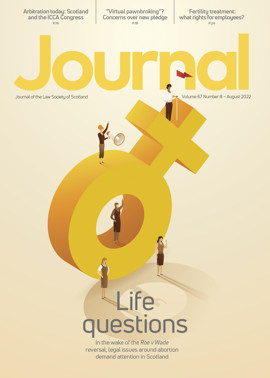The Roeing back of women’s rights?

Roe v Wade (1973) is one of the most famous US Supreme Court cases. It is considered by many as the case that legalised abortion. This is inaccurate: Roe simply changed the way individual states can regulate abortion, and it characterised abortion as covered under constitutional rights of privacy.
The case has remained at the forefront of US politics, with supporters heralding it as a beacon for women’s independence and equality, while critics viewed it as an overreach by the Supreme Court. Despite its surrounding controversy, Roe was the law of the land regarding abortion for almost 50 years, until 24 June 2022, when the court released its decision in Dobbs v Jackson Women’s Health, overturning Roe by a 6-3 majority.
Dobbs was a ruling issued to uphold Mississippi law banning most abortions after 15 weeks of pregnancy, and striking down constitutional protections for abortion care. With the Dobbs decision, the court’s conservative majority deemed Roe unconstitutional, ending 50 years of federal protections for abortion access. The ruling left it up to states whetherto outlaw or restrict abortion care.
That decision led to sharply divided reactions from the American public, reflecting the deep divisions of opinion there surrounding abortion rights. Around the world it also galvanised opinion, and has led many jurisdictions to review their own abortion laws and the extent of women’s legal rights to reproductive healthcare.
Scots law
In Scotland, the power to legislate in relation to abortion was devolved to the Scottish Parliament in 2016, under s 53 of the Scotland Act 2016. As in England & Wales, abortion is governed by the Abortion Act 1967, as amended by the Human Fertilisation and Embryology Act 1990. Section 1(1) of the 1967 Act provides that “a person shall not be guilty of an offence under the law relating to abortion when a pregnancy is terminated by a registered medical practitioner if two registered medical practitioners are of the opinion, formed in good faith –
- that the pregnancy has not exceeded its twenty-fourth week and that the continuance of the pregnancy would involve risk, greater than if the pregnancy were terminated, of injury to the physical or mental health of the pregnant woman or any existing children
of her family; or - that the termination is necessary to prevent grave permanent injury to the physical or mental health of the pregnant woman; or
- that the continuance of the pregnancy would involve risk to the life of the pregnant woman, greater than if the pregnancy were terminated; or
- that there is a substantial risk that if the child were born it would suffer from such physical or mental abnormalities as to be seriously handicapped”.
Therefore, as with Roe, the 1967 Act did not legalise abortion, which remains a crime throughout the UK: it simply provided a strict set of criteria under which the procedure is permissible. These criteria were established in the 1960s, when generations of women had died from unsafe abortions and decades before modern abortifacient medication was readily available. In Scotland, as of May 2022, it is now legal for women to have an abortion at home in the first 12 weeks of pregnancy using mifepristone and misoprostol (a combination of drugs which effectively end early gestation pregnancies).
Any induced abortion that did not comply with the set criteria would be dealt with under the pre-1967 law, which is different in Scotland compared with England & Wales. In the latter, depending on the circumstances, abortion could result in a charge under s 58 (if performed by the woman) or
s 59 (if performed by a third party) of the Offences Against the Person Act 1861, which makes it an offence to procure a miscarriage and carries a maximum penalty of life imprisonment. If the foetus was “capable of being born alive”, the alternative charge of “child destruction” (which carries the same penalty) would be available under s 1 of the Infant Life Preservation Act 1929. In Scotland, someone who induced a miscarriage could (depending on the facts) be charged with the common law crime of procuring an abortion. The 1967 Act has been described as a “curious” piece of legislation because it does not grant any rights to a person seeking to terminate their pregnancy. Instead, it creates an exemption from the crime where doctors carry out abortion procedures in accordance with its terms.
Scotland’s abortion summit
In the wake of the decision to overturn Roe, Scotland’s First Minister Nicola Sturgeon chaired an emergency abortion summit on 27 June that brought together representatives from local government, third sector organisations, Police Scotland, the NHS and campaigners, and cross-party representation. The First Minister described it as an opportunity to “reaffirm women’s autonomy and right to choose”, labelling the Dobbs ruling as “one of the darkest days for women’s rights in my lifetime”. She voiced concerns that the ruling would encourage the kind of anti-abortion activism seen in the United States to spread to the UK.
The abortion summit aimed to address the increasing prevalence of anti-abortion protests outside healthcare facilities that provide abortion services. Its express purpose was to ensure that women in Scotland can access services without fear, harassment or intimidation as a result of protests by anti-abortion demonstrations. The summit aimed to identify immediate, short-term actions available. As further discussed below, the Scottish Government has promised to look at long-term legislative mechanisms to establish buffer zones around clinics, which would prevent protests within 150 metres of healthcare facilities. Following the summit, the Government announced that “test” council byelaws on buffer zones would be attempted. Glasgow City Council, which has seen the most vociferous protests, was suggested as the initial test area.
In April, 76 clinicians at Queen Elizabeth University Hospital in Glasgow, the focus of anti-abortion protests, wrote to Maree Todd MSP, Minister for Women’s Health, urging her to take action to prevent the “judgment, intimidation and bullying” of staff and patients by protesters. These clinicians and other campaigners, such as Back Off Scotland and BPAS, acknowledge people’s right to protest but describe the protests as “emotional harassment”, which, in their view, should not be aimed at clinical sites but at the electoral body responsible for governance.
However, in a legal opinion released by COSLA in November 2021, Gerry Moynihan QC stated that a byelaw cannot be made where legislative authority to address the matter in question already exists (s 201(3) of the Local Government (Scotland) Act 1973): “Given the powers of the police under the Antisocial Behaviour etc (Scotland) Act 2004 to issue dispersal orders, addressing the matter in question, it is outwith the power of local authorities to use a byelaw to implement a buffer zone… For a local authority to make a byelaw, would breach the limitation in s 201(3) of the 1973 Act. Transfer of responsibility from the police to a council, or conferring concurrent responsibility, would require an Act of Parliament.”
The First Minister recognised that the byelaw measures proposed would very likely be challenged in court on human rights grounds, as they would limit the right to protest, but pledged that the Government would support any council “that seeks to, on a test case basis or a pilot basis, use byelaws… in the inevitable legal challenge they will face to that”.
Byelaws on buffer zones are likely to be a short-term measure, as the Scottish Government has stated its intent to legislate on the issue. This would ensure uniformity in the legal position across the country. However, the competence of legislation limiting the right to protest in this context is itself a matter of current controversy.
The Northern Ireland bill
In March 2022, the Northern Ireland Assembly voted for a bill to place buffer zones outside abortion clinics. The Abortion Services (Safe Access Zones) (Northern Ireland) Bill is being challenged by Northern Ireland’s Attorney General, Dame Brenda King. She has asked the UK Supreme Court to decide whether it “disproportionately interferes” with the rights of anti-abortion protesters. Dame Brenda’s intervention relates to clause 5(2)(a) of the bill, which relates to “influencing a protected person, whether directly or indirectly” without including an express “reasonable excuse” clause. Counsel for Dame Brenda argued that this breaches the European Convention on Human Rights, relating to the articles on freedom of religion and expression.
The case questions the legislative competence of the Northern Ireland Assembly, it being argued that it disproportionately interferes with the rights of persons who wish to express their opposition to the provision of abortion. In submissions to the court, the Lord Advocate of Scotland, Dorothy Bain QC, said there was “no necessity” to include the reasonable excuse defence in the bill, suggesting that the “competing rights” of individuals were already protected in the legislation, and that the personal autonomy rights of women accessing clinics needed to be upheld as well: “The effect of the conduct is targeting a vulnerable group directly, at the most vulnerable point in the process… Is this a process of protest? Is this not simply targeting a vulnerable group in order to persuade them to do something other than they have already decided to do?” She added that if the court determined that aspects of the bill merited reconsideration, that would be a “valuable exercise”, as similar legislation is currently being looked at by the Government in Scotland. The court heard the case on 22 July 2022, with judgment expected to be delivered later in the year.
Following Scotland’s abortion summit, the Government gave its support to a member’s bill brought by Green MSP Gillian McKay, to implement buffer zones around healthcare facilities in Scotland. McKay has said her bill could face a “huge problem” if the Supreme Court decides the legislation in Northern Ireland is not within Stormont’s competency.
Insufficient protections?
McKay’s proposal aims to establish buffer zones around women’s healthcare facilities, which would see 150 metre no-go areas created. The proposal outlines why she believes new national legislation is needed, and the existing legal provisions found in, for example, the Antisocial Behaviour etc (Scotland) Act 2004 are insufficient. For example, dispersal orders only last for three months and antisocial behaviour orders are applied to specific, named individuals and not to groups or gatherings.
Additionally, s 38 of the Criminal Justice and Licensing (Scotland) Act 2010 provides that a person commits an offence if they behave in a threatening or abusive manner likely to cause a reasonable person fear or alarm. The police can use this provision to arrest persons who intimidate abortion service users and cause them fear and alarm only after the intimidating behaviour has occurred and an offence has therefore been committed.
In addition, the victim of an offence would likely have to make a police report themselves, which may compound the distress already experienced. It would require service users to disclose the intimidation to the police and perhaps to give evidence in court about private medical treatment that they do not wish to be public knowledge.
Other offences such as common law breach of the peace provide for individuals to be arrested if they engage in “conduct severe enough to cause alarm to ordinary people and threaten serious disturbance to the community”. This definition presents an issue in the case of clinic protests as much of this action is unlikely to “threaten serious disturbance to the community”, being targeted at individual women accessing services. The same concerns apply to this common law offence as to the offence under s 38 of the 2010 Act.
The First Minister has said she firmly believes that legislation is the correct long-term solution, but supporters of the measure have to recognise that buffer zones could breach the European Convention, which protects free speech. Scottish ministers will have to wait for the Supreme Court to rule on the Northern Ireland Bill to see whether that clarifies the legal situation.
Despite the competing arguments around the morality and legality of abortion, it is now one of the safest and most frequently used medical procedures across the world, and one that around one in three women will experience in their lifetime. According to the World Health Organisation, when safe access to abortion is hindered, it does not reduce the number of abortions; instead, the number of unsafe abortions with fatal consequences increases. This is evidenced in the fact that unsafe abortions are the third leading cause of maternal deaths worldwide and lead to an additional 5 million largely preventable disabilities. Being able to exercise one’s legal rights without fear and harassment is a fundamental value of the rule of law and, in this context, is an area in which the Scottish Government (with cross-party support) seems determined to act if it can.
Regulars
Perspectives
Features
Briefings
- Criminal court: Long road against addiction
- Family: CGT reforms in the pipeline
- Employment: Long COVID as a disability
- Human rights: civil rights not engaged by legal aid bid
- Pensions: A neverending story – fraud update
- Scottish Solicitors' Discipline Tribunal: August 2022
- Property: The RoS arrear: any light in the tunnel?
- In-house: As the workplace evolves







